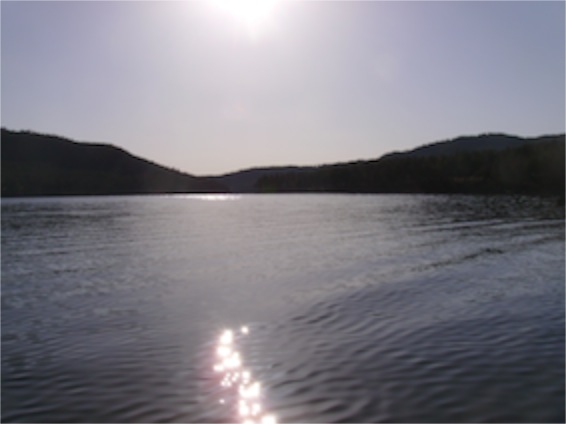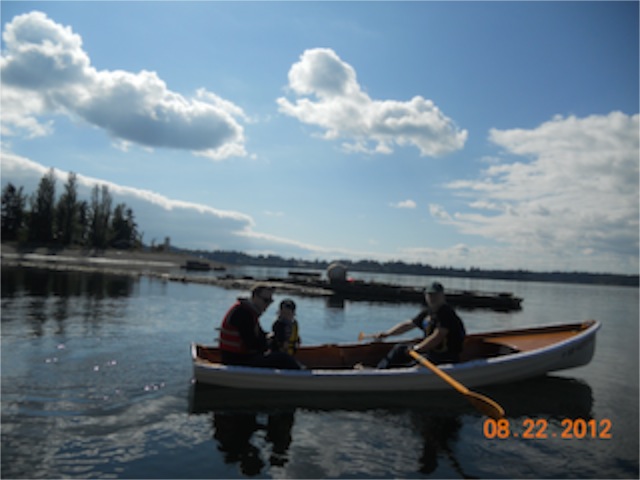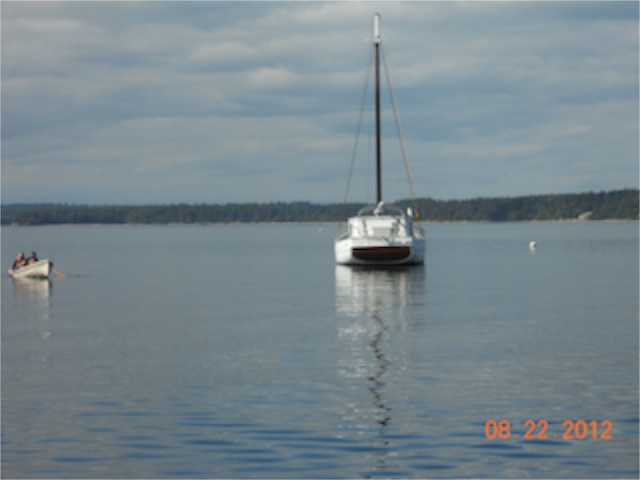Of Boats
26/08/12 04:25
The technologies of water transportation have their roots in ancient times. There are all kinds of technological innovations that are a part of modern marine transportation, but the basics of hull design, displacement, and navigation have been known by humans for millennia. When ancient texts such as the Bible or Homer’s Illiad speak of ships, rowing and sailing, we know what they mean in part because we still have boats that are rowed and sailed.
 For most of the history of humans on this planet, people and goods have traveled on the water by two methods, rowing and sailing. While the residents of Europe and much of Asia developed sophisticated rowing craft, with the rowers facing the stern of the boat and pulling with their whole bodies, in other parts of the globe, paddling was the norm. Different boats were developed to suit different conditions, different sources of building materials, and different uses.
For most of the history of humans on this planet, people and goods have traveled on the water by two methods, rowing and sailing. While the residents of Europe and much of Asia developed sophisticated rowing craft, with the rowers facing the stern of the boat and pulling with their whole bodies, in other parts of the globe, paddling was the norm. Different boats were developed to suit different conditions, different sources of building materials, and different uses.
The basic design of a Greenland Kayak, for example, is nearly perfectly suited to its environment. The skin-on-frame boats were stable in rough seas, easy to paddle, light and quick enough for hunting, and provided a warm environment for the legs of the paddler. They are easily paddled and, when their useful life is past, they deteriorate back into nature without leaving any lasting residue or pollution.
I don’t know what the initial contact between Europeans and the residents of North America was like, but I imagine that it was a fairly rapid exchange of marine technologies. The Europeans arrived in large sailing vessels and launched smaller pulling boats that were probably beamy and relatively slow in the water. The indigenous people paddled their canoes out to the visitors curious about their craft. The visitors must have noticed how nimble in the water, easy to paddle, quick and maneuverable canoes were. Both sides probably developed an admiration for parts of the others’ technology.
Wood has been the primary building material for boats until the last couple of hundred years or so. It is well suited to being shaped to provide for a smooth passage through the water. It is relatively durable and flexible enough to take the pounding of waves. And it has the remarkable quality of swelling when it is placed in water, which means that joints tighten and leaks disappear when wooden boats are launched.
My little boats have followed ancient designs. My canoes and kayaks are modern reproductions of shapes that have been a part of boats for thousands of years. My rowboat follows a design that was common in New England hundreds of years ago. But the construction and materials I use would not be familiar to ancient boat builders. For one thing, all of my boats except the skin-on-frame kayak have a think layer of fiberglass to seal the wood and protect the boat from the abrasion of sand and gravel on the shore. I have used plywood as the primary material for my rowboat, with sophisticated adhesives joining the thin layers of wood to make the panels. Those panels were precisely cut with a computer-guided CNC machine to make the shape come out just right. That is a far cry from ancient boats that were built by craftsmen who had skilled eyes for proportion. Many of the dimensions of light craft are based on human body parts, so that each boat was a bit different in size depending on the size of the builder.
 It is fun to think of the heritage of boats as I paddle around a harbor. The Puget Sound is home to some really beautiful wooden boats. The traditions of boatbuilding are long established on these shores and there are many who have invested a lot in building, maintaining and restoring beautiful craft. The forests of the Pacific Northwest provide a ready source of Cedar, Spruce and other woods that are well suited for boat building. The traditions and skills of craftsmanship have been handed down for generations in some of the shops that are located along the shores of the sound.
It is fun to think of the heritage of boats as I paddle around a harbor. The Puget Sound is home to some really beautiful wooden boats. The traditions of boatbuilding are long established on these shores and there are many who have invested a lot in building, maintaining and restoring beautiful craft. The forests of the Pacific Northwest provide a ready source of Cedar, Spruce and other woods that are well suited for boat building. The traditions and skills of craftsmanship have been handed down for generations in some of the shops that are located along the shores of the sound.
Sometimes when I row or paddle in this area I just wander around the boats in the harbor looking at the various shapes and conditions of the boats. The owners of the boats tend to be a friendly lot and my little craft garner some attention from them. I’ve never developed the desire or the means to care for a big boat and I live in the wrong part of the country for a live-aboard, but I can imagine what it might be like and I appreciate the dedication of those who have made a particular boat their life’s work.
Even the most pristine of wooden ships, however, have made concessions to modern times. Marine Radios and GPS navigation devices are present in virtually all of the craft that venture very far from shore. I appreciate it when a boat owner works to hide the antennas and modern gear, but I am also grateful that they use modern technologies to add safety to their travels. Many of the larger boats have electrical systems to provide light and power for various devices. Solar battery chargers are popular on the water and make sense for extended voyaging away from shore power. Some craft carry generators and inverters to power appliances such as microwaves and ice makers.
 I don’t live on my boats. I don’t even spend all that much time in them. They are vehicles for recreation only. They provide exercise and perspective and entertainment for me. They allow short adventures and enable me to visit places and see things that I would miss if I remained land-locked. And human-powered boats are just right for an overweight middle-aged guy who needs to keep exercising to remain fit. When I take someone for a ride in my rowboat or a canoe, I provide the propulsion and enjoy doing so. It is a pleasant form of exercise.
I don’t live on my boats. I don’t even spend all that much time in them. They are vehicles for recreation only. They provide exercise and perspective and entertainment for me. They allow short adventures and enable me to visit places and see things that I would miss if I remained land-locked. And human-powered boats are just right for an overweight middle-aged guy who needs to keep exercising to remain fit. When I take someone for a ride in my rowboat or a canoe, I provide the propulsion and enjoy doing so. It is a pleasant form of exercise.
I think it is good for my little boats to occasionally visit the harbor and be paddled among the larger and more sophisticated craft. The similarities and differences between the different boats interest me. But I know that this is only a visit. Tomorrow the trailer will be headed east and we’ll be headed home. The boats will spend the winter in storage and I will think of other building projects.
Still it is sweet to visit these waters and enjoy this place before moving on.

The basic design of a Greenland Kayak, for example, is nearly perfectly suited to its environment. The skin-on-frame boats were stable in rough seas, easy to paddle, light and quick enough for hunting, and provided a warm environment for the legs of the paddler. They are easily paddled and, when their useful life is past, they deteriorate back into nature without leaving any lasting residue or pollution.
I don’t know what the initial contact between Europeans and the residents of North America was like, but I imagine that it was a fairly rapid exchange of marine technologies. The Europeans arrived in large sailing vessels and launched smaller pulling boats that were probably beamy and relatively slow in the water. The indigenous people paddled their canoes out to the visitors curious about their craft. The visitors must have noticed how nimble in the water, easy to paddle, quick and maneuverable canoes were. Both sides probably developed an admiration for parts of the others’ technology.
Wood has been the primary building material for boats until the last couple of hundred years or so. It is well suited to being shaped to provide for a smooth passage through the water. It is relatively durable and flexible enough to take the pounding of waves. And it has the remarkable quality of swelling when it is placed in water, which means that joints tighten and leaks disappear when wooden boats are launched.
My little boats have followed ancient designs. My canoes and kayaks are modern reproductions of shapes that have been a part of boats for thousands of years. My rowboat follows a design that was common in New England hundreds of years ago. But the construction and materials I use would not be familiar to ancient boat builders. For one thing, all of my boats except the skin-on-frame kayak have a think layer of fiberglass to seal the wood and protect the boat from the abrasion of sand and gravel on the shore. I have used plywood as the primary material for my rowboat, with sophisticated adhesives joining the thin layers of wood to make the panels. Those panels were precisely cut with a computer-guided CNC machine to make the shape come out just right. That is a far cry from ancient boats that were built by craftsmen who had skilled eyes for proportion. Many of the dimensions of light craft are based on human body parts, so that each boat was a bit different in size depending on the size of the builder.

Sometimes when I row or paddle in this area I just wander around the boats in the harbor looking at the various shapes and conditions of the boats. The owners of the boats tend to be a friendly lot and my little craft garner some attention from them. I’ve never developed the desire or the means to care for a big boat and I live in the wrong part of the country for a live-aboard, but I can imagine what it might be like and I appreciate the dedication of those who have made a particular boat their life’s work.
Even the most pristine of wooden ships, however, have made concessions to modern times. Marine Radios and GPS navigation devices are present in virtually all of the craft that venture very far from shore. I appreciate it when a boat owner works to hide the antennas and modern gear, but I am also grateful that they use modern technologies to add safety to their travels. Many of the larger boats have electrical systems to provide light and power for various devices. Solar battery chargers are popular on the water and make sense for extended voyaging away from shore power. Some craft carry generators and inverters to power appliances such as microwaves and ice makers.

I think it is good for my little boats to occasionally visit the harbor and be paddled among the larger and more sophisticated craft. The similarities and differences between the different boats interest me. But I know that this is only a visit. Tomorrow the trailer will be headed east and we’ll be headed home. The boats will spend the winter in storage and I will think of other building projects.
Still it is sweet to visit these waters and enjoy this place before moving on.